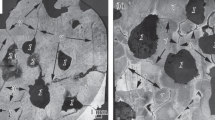Abstract
Native silicon and iron silicides were studied in the Dhofar 280 lunar anorthositic meteorite representing an impact-melt breccia. Such rocks are widespread in the highland crust of the Moon. It was established that cryptocrystalline objects containing native silicon are close in composition to the silicon monoxide SiO. Experimental data demonstrate that this compound is the main component of the vapor forming during vaporization of an anorthitic melt. It is suggested that the formation of native silicon was related to the condensation of SiO from an impact-derived vapor cloud. Reducing conditions are determined by the mass-fractionation of silica monoxide and oxygen in the expanding vapor cloud in the gravity field of the Moon. Gaseous SiO may be condensed directly into a solid phase or a mixture of silicon with silica. The condensed SiO phase incorporated into an impact melt should be decomposed into silicon and silica. Interaction of Si, SiO, and SiO2 solid condensates with an impact melt could lead to the observed enrichment of the surrounding liquid in silica. The formation of iron silicides is provided by the reaction of native silicon with FeO presenting in an impact melt. The other iron source could be a meteoritic component, which is identified in silicides by elevated Ni contents. Obtained mineralogical and experimental data show that metallic silicon can be obtained under lunar conditions by distillation of anorthositic melts and can be used for production of solar batteries to provide lunar settlements with energy.
Similar content being viewed by others
References
Anand, M., Taylor, L.A., Nazarov, M.A., et al., Space weathering on airless planetary bodies: clues from lunar mineral hapkeite, Proc. National Academ. Sci. USA, 2004, vol. 101, no. 18, pp. 6847–6851.
Anosova, M.O., Nazarov, M.A., Demidova, S.I., et al., Trace element chemistry of a silicon-bearing association in the Dhofar 280 lunar meteorite, 43rd Lunar Planet. Sci., 2012, abstract #1079.pdf.
Badyukov, D.D., Rusakov, V.S., and Kupin, Yu.G., Shock wave-induced interaction between meteoritic iron and silicates, Petrology, 2012, vol. 20, no. 4, pp. 347–355.
Bannykh, O.A., Budberg, P.B., Alisova, S.P., et al., Phase diagram for iron based double and multicomponent systems, in Spravochnik (Reference Book), Moscow: Metallurgiya, 1986.
Demidova, S.I., Nazarov, M.A., Lorenz, K.A., et al., Chemical composition of lunar meteorites and the lunar crust, Petrology, 2007, vol. 16, no. 4, pp. 386–407.
Dikov, Yu.P., Bogatikov, O.A., Barsukov, V.L., et al., Some features of the main element conditions in surface layers of the regolith particles of the Luna automatic stations samples: X-ray photoelectronic spectroscopy studies, 9th Lunar Planet. Sci. Conf., 1978, pp. 2111–2124.
Glushko, V.P., Gurvich, L.V., Bergman, G.A., et al., Thermodynamic properties of individual substances, in Spravochnik (Reference Book), Glushko, V.P., Ed., Moscow: Nauka, 1979, vol. 2, book 2.
Grossman, L., Condensation in the primitive solar nebula, Geochim. Cosmochim. Acta, 1972, vol. 36, no. 5, pp. 597–619.
Hiltl, M., Bauer, F., Ermstson, K., et al., SEM and tem analyses of minerals xifengite, gupeiite, Fe2Si (hapkeite?), titanium carbide (TiC) and cubic moissanite (SiC) from the subsoil in the Alpine Foreland: are they cosmochemical?, 42nd Lunar Planet. Sci. Conf., 2011, #1391.pdf.
Keller, L.P. and McKay, D.S., Micrometer-sized glass spheres in Apollo 16 soil 61181: implications for impact volatilization and condensation, 22nd Lunar Planet. Sci. Conf., 1992, pp. 137–141.
Lodders, K. and Fegley, B., Jr. The origin of circumstellar silicon carbide grains found in meteorites, Meteorit. Planet. Sci, 1995, vol. 30, pp. 661–678.
Markova, O.M., Yakovlev, O.I., Semenov, G.A., and Belov, A.N., Some general results of experiments on the evaporation of natural melts in a Knudesen cell, Geokhimiya, 1986, no. 11, pp. 1559–1569.
Nazarov, M.A., Demidova, S.I., Anosova, M.O., et al., Native silicon and iron silicides in the Dhofar 280 lunar meteorite, Petrology, 2012a, vol. 20, no. 6, pp. 506–519.
Nazarov, M.A., Demidova, S.I., Ntaflos, Th., and Brandstaetter, F., Native silicon, Fe-silicides and a condensate lithology in the Dhofar 280 lunar meteorite, 43rd Lunar Planet. Sci. Conf., 2012b, #1073.pdf.
Nazarov, M.A., Demidova, S.I., Ntaflos, Th., and Brandstaetter, F., Origin of native silicon and Fe-silicides in lunar rocks, 45th Lunar Planet. Sci. Conf., 2014, #1090.pdf.
Rowan, L.R. and Ahrens, T.J., Observations of impact-induced molten metal-silicate partitioning, Earth Planet. Sci. Lett., 1994, vol. 122, pp. 71–88.
Shornikov, S.I., Thermodynamic properties of molecules existing in vapor above the Si-O system, in Kvarts. Kremnezem. Materialy Mezhdunar. seminara, Syktyvkar, 2004 (Proceedings of International Conference on Quartz, Silicon,) Syktyvkar: 2004, pp. 223–224.
Shornikov, S.I., Archakov, I.Yu., and Chemekova, T.Yu., A mass spectrometric study of the thermodynamic properties of Al2O3-SiO2 melts, Russ. J. Phys. Chem., 2000, vol. 74, no. 5, pp. 684–688.
Shornikov, S.I., Stolyarova, V.L., and Shul’ts, M.M., Massspectrometric study of properties of the melt in the CaO-Al2O3-SiO2 system, Tekhnika Tekhnol. Silikat., 1996, vol. 3, nos. 1–2, pp. 8–22.
Spicuzza, M.J., Valley, J.W., Fournelle, J., et al., Native silicon and Fe-silicides from the Apollo 16 lunar regolith: extreme reduction, metal-silicate immiscibility, and shock melting, 42nd Lunar Planet. Sci. Conf., 2011, Abstract #2231.pdf.
Toropov, N.A., Barzakovskii, V.P., Bondar’, I.A., and Udalov, Yu.P., Phase Diagrammy sostoyaniya silikatnykh sistem. Vyp. 2. Metall-kislorodnye soedineniya silikatnykh sistem, (Phase Diagrams of Silicate Systems. Vol. 2. Metal-Oxygen Compounds of Silicate Systems), Leningrad: Nauka, 1969.
Yakovlev, O.I., Gerasimov, M.V., and Dikov, Yu.P., Estimation of temperature conditions for the formation of HASP and GASP glasses from the lunar regolith, Geochem. Int., 2011, vol. 49, no. 3, pp. 213–223.
Yakovlev, O.I., Markova, O.M., and Manzon, B.M., Role of vaporization in the dissipation and formation of the Moon, Geokhimiya, 1987, no. 4, pp. 467–482.
Zuxiang, Yu., Two new minerals gupeiite and xifengite in cosmic dusts from Yanshan, Acta Petrol. Mineral. Analytica, 1984, vol. 3, no. 3, pp. 231–238.
Author information
Authors and Affiliations
Corresponding author
Additional information
Original Russian Text © M.A. Nazarov, S.I. Shornikov, S.I. Demidova, 2015, published in Petrologiya, 2015, Vol. 23, No. 2, pp. 186–194.
Rights and permissions
About this article
Cite this article
Nazarov, M.A., Shornikov, S.I. & Demidova, S.I. Origin of native silicon and iron silicides in the Dhofar 280 lunar meteorite. Petrology 23, 168–175 (2015). https://doi.org/10.1134/S0869591115020071
Received:
Published:
Issue Date:
DOI: https://doi.org/10.1134/S0869591115020071




